Comprehensive Marketing Plan Report - Business Strategy
VerifiedAdded on 2023/06/03
|25
|6394
|181
Report
AI Summary
This marketing plan assignment provides a comprehensive overview of the business-marketing planning process. It begins by defining marketing and exploring key concepts such as production, selling, and marketing concepts, alongside a discussion on marketing philosophy. The report delves into the key objectives of marketing practitioners, including financial, strategic, and communication objectives, and provides a detailed marketing audit. The marketing audit covers situational factors (COMP) and the business marketing planning process (CADDIE). Furthermore, the report explores the marketing action plan, design thinking, and blue ocean thinking to create a holistic understanding of marketing strategies. The assignment is structured to identify, develop, and implement effective marketing goals, objectives, and tactics within a business context.

Running head: MARKETING PLAN 1
Marketing Plan
Name of Student
Name of University
Marketing Plan
Name of Student
Name of University
Paraphrase This Document
Need a fresh take? Get an instant paraphrase of this document with our AI Paraphraser
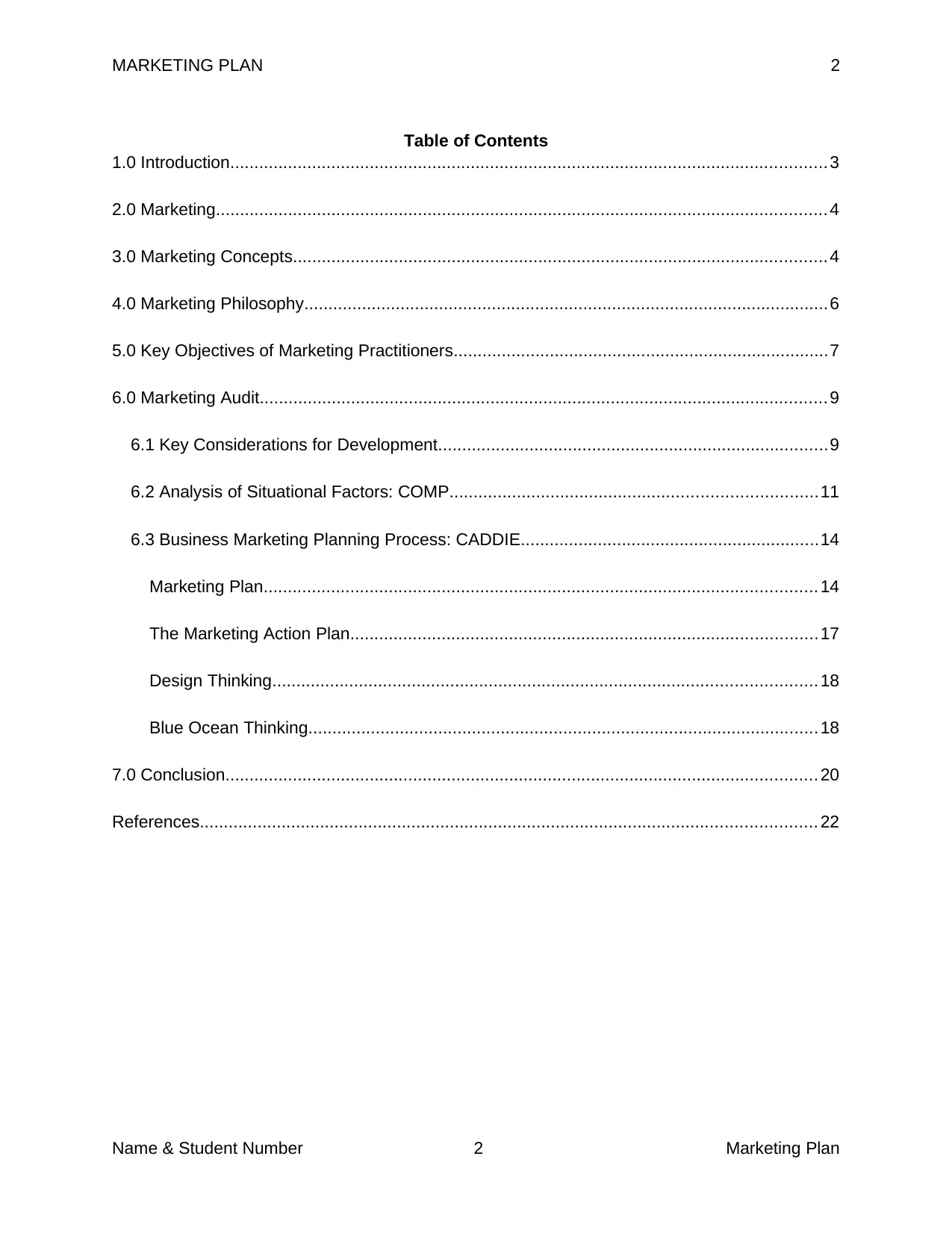
MARKETING PLAN 2
Table of Contents
1.0 Introduction............................................................................................................................ 3
2.0 Marketing............................................................................................................................... 4
3.0 Marketing Concepts............................................................................................................... 4
4.0 Marketing Philosophy............................................................................................................. 6
5.0 Key Objectives of Marketing Practitioners..............................................................................7
6.0 Marketing Audit...................................................................................................................... 9
6.1 Key Considerations for Development.................................................................................9
6.2 Analysis of Situational Factors: COMP............................................................................11
6.3 Business Marketing Planning Process: CADDIE..............................................................14
Marketing Plan................................................................................................................... 14
The Marketing Action Plan.................................................................................................17
Design Thinking................................................................................................................. 18
Blue Ocean Thinking..........................................................................................................18
7.0 Conclusion........................................................................................................................... 20
References................................................................................................................................ 22
Name & Student Number 2 Marketing Plan
Table of Contents
1.0 Introduction............................................................................................................................ 3
2.0 Marketing............................................................................................................................... 4
3.0 Marketing Concepts............................................................................................................... 4
4.0 Marketing Philosophy............................................................................................................. 6
5.0 Key Objectives of Marketing Practitioners..............................................................................7
6.0 Marketing Audit...................................................................................................................... 9
6.1 Key Considerations for Development.................................................................................9
6.2 Analysis of Situational Factors: COMP............................................................................11
6.3 Business Marketing Planning Process: CADDIE..............................................................14
Marketing Plan................................................................................................................... 14
The Marketing Action Plan.................................................................................................17
Design Thinking................................................................................................................. 18
Blue Ocean Thinking..........................................................................................................18
7.0 Conclusion........................................................................................................................... 20
References................................................................................................................................ 22
Name & Student Number 2 Marketing Plan

MARKETING PLAN 3
1.0 Introduction
The business-marketing planning process is identified as a systematic way of identifying,
developing and implementing goals, objectives, tactics and strategic approach of an
organisation (Fanning, 2018). This aspect of organisational business strategic planning is
applicable to a wide range of activities and situations, some of them being developing a new
product, repositioning of an existing organisation, expansion to new scope and opportunities
and several other factors.
The following paper provides a detailed description of the business-marketing planning
process of an organisation in the present environmental context. In this regard, the paper has
taken into consideration discussing what marketing is from an organisational point of view as
well as its associated concepts in great detail. Furthermore, the important concept associated
with business-marketing planning process, marketing philosophy has also been taken into
consideration along with the identification of primary objectives to be used by marketing
practitioner in this regard (Fanning, 2018). It has also provided an elaborated discussion of
marketing audit, the primary backbone of an organisational marketing initiative along with a
variety of situational factors (COMP) as well a theoretical framework like CADDIE. A brief
description of the identified marketing audit concepts has been provided along with its relative
importance in an organisational context. The marketing plan thereby discussed in the following
section has also determined ways by which the effectiveness of marketing audit factors is likely
to be measured in accordance to the present business environmental situation. Such a
marketing audit would facilitate the practitioners to analyse the important marketing concepts,
the association of such impacts for procuring important information and the processing of the
techniques to obtain the objectives.
Name & Student Number 3 Marketing Plan
1.0 Introduction
The business-marketing planning process is identified as a systematic way of identifying,
developing and implementing goals, objectives, tactics and strategic approach of an
organisation (Fanning, 2018). This aspect of organisational business strategic planning is
applicable to a wide range of activities and situations, some of them being developing a new
product, repositioning of an existing organisation, expansion to new scope and opportunities
and several other factors.
The following paper provides a detailed description of the business-marketing planning
process of an organisation in the present environmental context. In this regard, the paper has
taken into consideration discussing what marketing is from an organisational point of view as
well as its associated concepts in great detail. Furthermore, the important concept associated
with business-marketing planning process, marketing philosophy has also been taken into
consideration along with the identification of primary objectives to be used by marketing
practitioner in this regard (Fanning, 2018). It has also provided an elaborated discussion of
marketing audit, the primary backbone of an organisational marketing initiative along with a
variety of situational factors (COMP) as well a theoretical framework like CADDIE. A brief
description of the identified marketing audit concepts has been provided along with its relative
importance in an organisational context. The marketing plan thereby discussed in the following
section has also determined ways by which the effectiveness of marketing audit factors is likely
to be measured in accordance to the present business environmental situation. Such a
marketing audit would facilitate the practitioners to analyse the important marketing concepts,
the association of such impacts for procuring important information and the processing of the
techniques to obtain the objectives.
Name & Student Number 3 Marketing Plan
⊘ This is a preview!⊘
Do you want full access?
Subscribe today to unlock all pages.

Trusted by 1+ million students worldwide

MARKETING PLAN 4
2.0 Marketing
According to Fanning (2018), Marketing can be defined as an activity undertaken as well
as redirected towards human beings for the purpose of satisfying the widespread needs,
demands and wants. It primarily involves exchange between the two or more parties involved in
the process. The human activity factor tends to highlight the very objective of an organisational
marketing initiative comprising of communicating and promoting the customers in relation to any
particular product or service (Fanning, 2018). The primary focus in this regard however ensures
need, demand and want satisfaction of the target customers. As a result, it is quite evident that
marketing seems to be day to day activity of an organisation in which the customers play a very
crucial role. The development of effective business marketing plan seems to be of immense
significance in accomplishing the strategic business goals.
Questionnaire:
1. Primary objective of marketing is to cater to the needs and demands of customers
O Yes O No
2. Marketing objective of an organisation comprises of
O Communication O Interaction O Promotion
3.0 Marketing Concepts
The marketing concepts seems to be highly significant in relation to determining an
effective business plan that has largely taken into consideration each of the aspects associated
with the present needs and demands of customers (Fanning, 2018). As a result, it is essential
for the organisations to determine which of the interests and requirements that it needs to take
Name & Student Number 4 Marketing Plan
2.0 Marketing
According to Fanning (2018), Marketing can be defined as an activity undertaken as well
as redirected towards human beings for the purpose of satisfying the widespread needs,
demands and wants. It primarily involves exchange between the two or more parties involved in
the process. The human activity factor tends to highlight the very objective of an organisational
marketing initiative comprising of communicating and promoting the customers in relation to any
particular product or service (Fanning, 2018). The primary focus in this regard however ensures
need, demand and want satisfaction of the target customers. As a result, it is quite evident that
marketing seems to be day to day activity of an organisation in which the customers play a very
crucial role. The development of effective business marketing plan seems to be of immense
significance in accomplishing the strategic business goals.
Questionnaire:
1. Primary objective of marketing is to cater to the needs and demands of customers
O Yes O No
2. Marketing objective of an organisation comprises of
O Communication O Interaction O Promotion
3.0 Marketing Concepts
The marketing concepts seems to be highly significant in relation to determining an
effective business plan that has largely taken into consideration each of the aspects associated
with the present needs and demands of customers (Fanning, 2018). As a result, it is essential
for the organisations to determine which of the interests and requirements that it needs to take
Name & Student Number 4 Marketing Plan
Paraphrase This Document
Need a fresh take? Get an instant paraphrase of this document with our AI Paraphraser
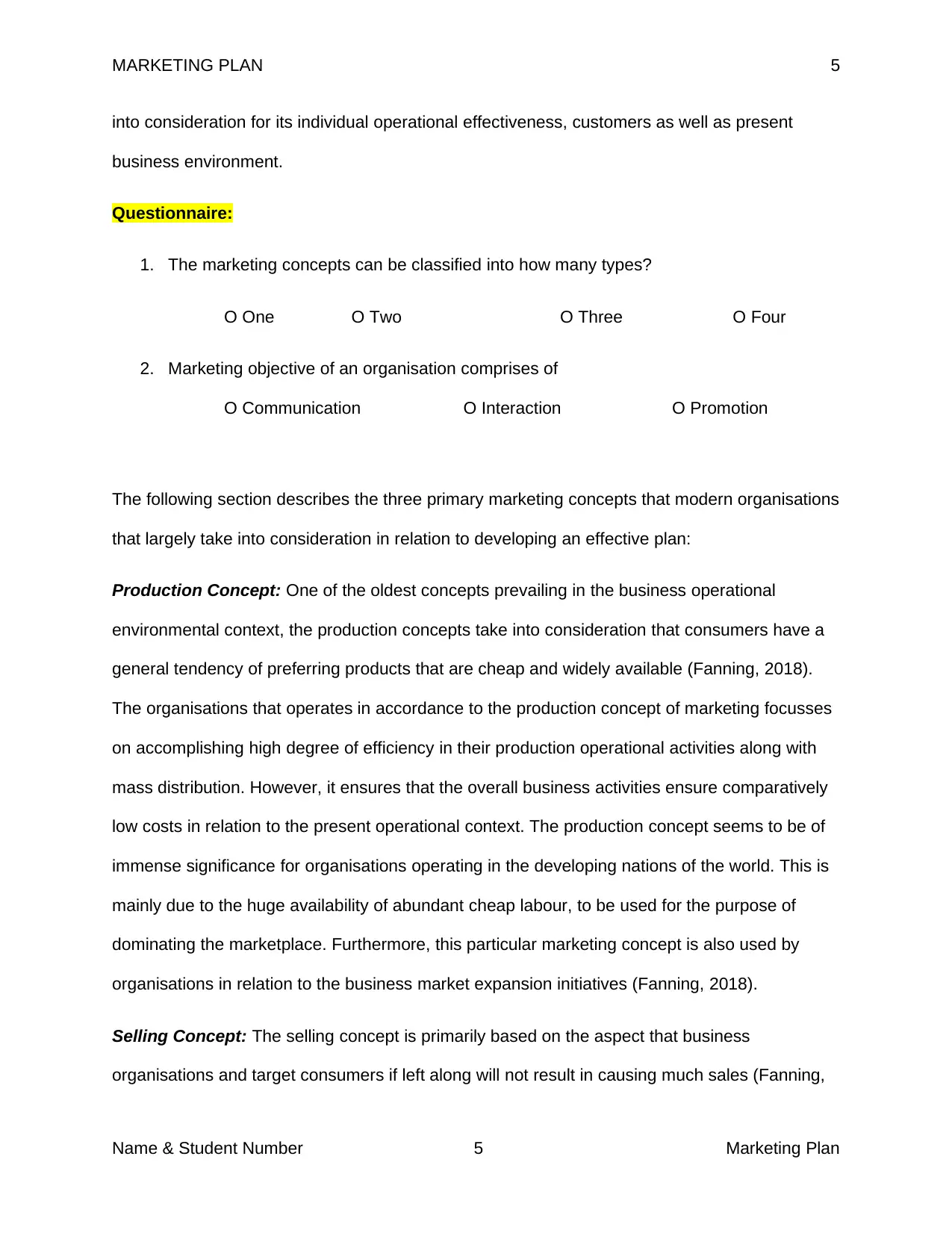
MARKETING PLAN 5
into consideration for its individual operational effectiveness, customers as well as present
business environment.
Questionnaire:
1. The marketing concepts can be classified into how many types?
O One O Two O Three O Four
2. Marketing objective of an organisation comprises of
O Communication O Interaction O Promotion
The following section describes the three primary marketing concepts that modern organisations
that largely take into consideration in relation to developing an effective plan:
Production Concept: One of the oldest concepts prevailing in the business operational
environmental context, the production concepts take into consideration that consumers have a
general tendency of preferring products that are cheap and widely available (Fanning, 2018).
The organisations that operates in accordance to the production concept of marketing focusses
on accomplishing high degree of efficiency in their production operational activities along with
mass distribution. However, it ensures that the overall business activities ensure comparatively
low costs in relation to the present operational context. The production concept seems to be of
immense significance for organisations operating in the developing nations of the world. This is
mainly due to the huge availability of abundant cheap labour, to be used for the purpose of
dominating the marketplace. Furthermore, this particular marketing concept is also used by
organisations in relation to the business market expansion initiatives (Fanning, 2018).
Selling Concept: The selling concept is primarily based on the aspect that business
organisations and target consumers if left along will not result in causing much sales (Fanning,
Name & Student Number 5 Marketing Plan
into consideration for its individual operational effectiveness, customers as well as present
business environment.
Questionnaire:
1. The marketing concepts can be classified into how many types?
O One O Two O Three O Four
2. Marketing objective of an organisation comprises of
O Communication O Interaction O Promotion
The following section describes the three primary marketing concepts that modern organisations
that largely take into consideration in relation to developing an effective plan:
Production Concept: One of the oldest concepts prevailing in the business operational
environmental context, the production concepts take into consideration that consumers have a
general tendency of preferring products that are cheap and widely available (Fanning, 2018).
The organisations that operates in accordance to the production concept of marketing focusses
on accomplishing high degree of efficiency in their production operational activities along with
mass distribution. However, it ensures that the overall business activities ensure comparatively
low costs in relation to the present operational context. The production concept seems to be of
immense significance for organisations operating in the developing nations of the world. This is
mainly due to the huge availability of abundant cheap labour, to be used for the purpose of
dominating the marketplace. Furthermore, this particular marketing concept is also used by
organisations in relation to the business market expansion initiatives (Fanning, 2018).
Selling Concept: The selling concept is primarily based on the aspect that business
organisations and target consumers if left along will not result in causing much sales (Fanning,
Name & Student Number 5 Marketing Plan
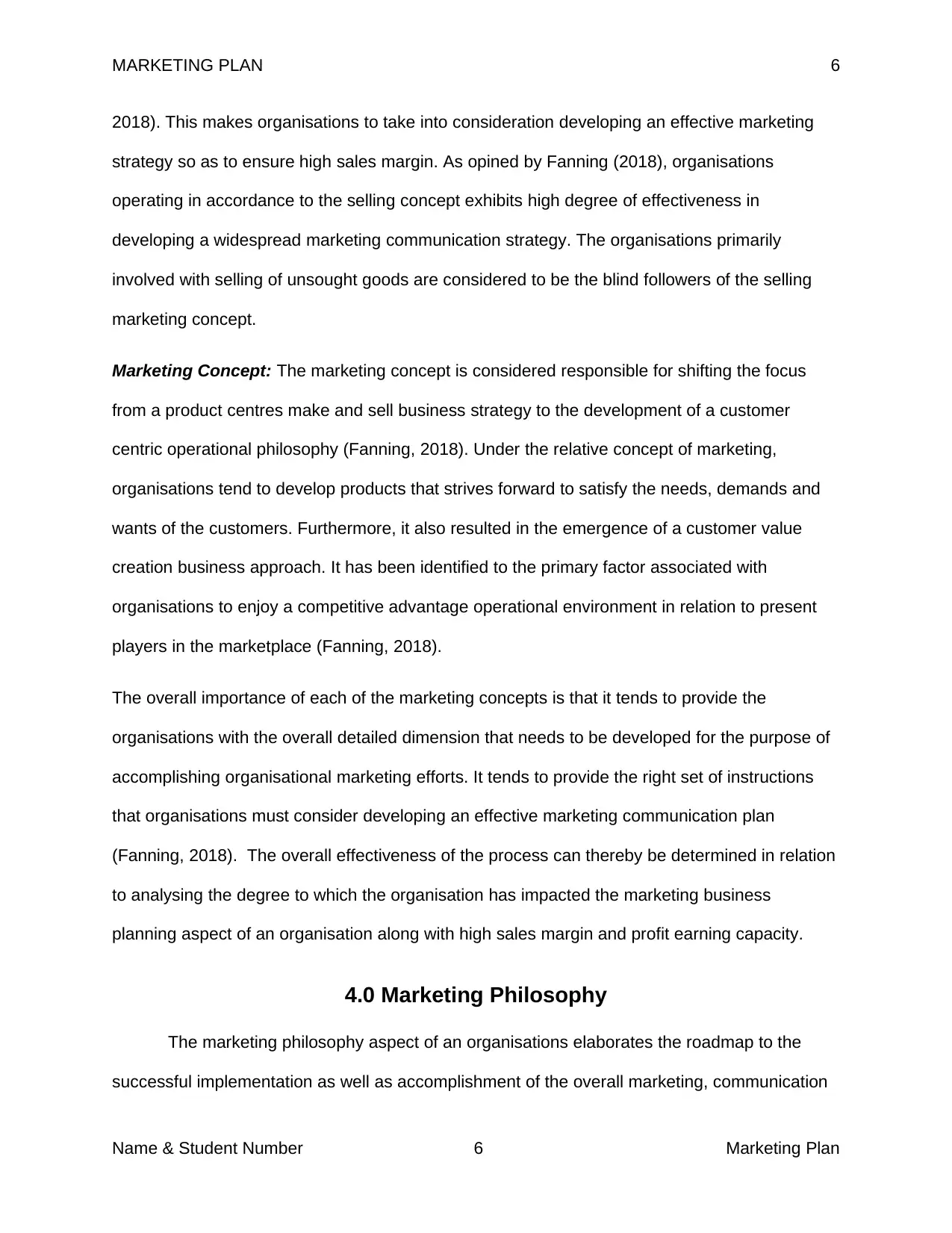
MARKETING PLAN 6
2018). This makes organisations to take into consideration developing an effective marketing
strategy so as to ensure high sales margin. As opined by Fanning (2018), organisations
operating in accordance to the selling concept exhibits high degree of effectiveness in
developing a widespread marketing communication strategy. The organisations primarily
involved with selling of unsought goods are considered to be the blind followers of the selling
marketing concept.
Marketing Concept: The marketing concept is considered responsible for shifting the focus
from a product centres make and sell business strategy to the development of a customer
centric operational philosophy (Fanning, 2018). Under the relative concept of marketing,
organisations tend to develop products that strives forward to satisfy the needs, demands and
wants of the customers. Furthermore, it also resulted in the emergence of a customer value
creation business approach. It has been identified to the primary factor associated with
organisations to enjoy a competitive advantage operational environment in relation to present
players in the marketplace (Fanning, 2018).
The overall importance of each of the marketing concepts is that it tends to provide the
organisations with the overall detailed dimension that needs to be developed for the purpose of
accomplishing organisational marketing efforts. It tends to provide the right set of instructions
that organisations must consider developing an effective marketing communication plan
(Fanning, 2018). The overall effectiveness of the process can thereby be determined in relation
to analysing the degree to which the organisation has impacted the marketing business
planning aspect of an organisation along with high sales margin and profit earning capacity.
4.0 Marketing Philosophy
The marketing philosophy aspect of an organisations elaborates the roadmap to the
successful implementation as well as accomplishment of the overall marketing, communication
Name & Student Number 6 Marketing Plan
2018). This makes organisations to take into consideration developing an effective marketing
strategy so as to ensure high sales margin. As opined by Fanning (2018), organisations
operating in accordance to the selling concept exhibits high degree of effectiveness in
developing a widespread marketing communication strategy. The organisations primarily
involved with selling of unsought goods are considered to be the blind followers of the selling
marketing concept.
Marketing Concept: The marketing concept is considered responsible for shifting the focus
from a product centres make and sell business strategy to the development of a customer
centric operational philosophy (Fanning, 2018). Under the relative concept of marketing,
organisations tend to develop products that strives forward to satisfy the needs, demands and
wants of the customers. Furthermore, it also resulted in the emergence of a customer value
creation business approach. It has been identified to the primary factor associated with
organisations to enjoy a competitive advantage operational environment in relation to present
players in the marketplace (Fanning, 2018).
The overall importance of each of the marketing concepts is that it tends to provide the
organisations with the overall detailed dimension that needs to be developed for the purpose of
accomplishing organisational marketing efforts. It tends to provide the right set of instructions
that organisations must consider developing an effective marketing communication plan
(Fanning, 2018). The overall effectiveness of the process can thereby be determined in relation
to analysing the degree to which the organisation has impacted the marketing business
planning aspect of an organisation along with high sales margin and profit earning capacity.
4.0 Marketing Philosophy
The marketing philosophy aspect of an organisations elaborates the roadmap to the
successful implementation as well as accomplishment of the overall marketing, communication
Name & Student Number 6 Marketing Plan
⊘ This is a preview!⊘
Do you want full access?
Subscribe today to unlock all pages.

Trusted by 1+ million students worldwide
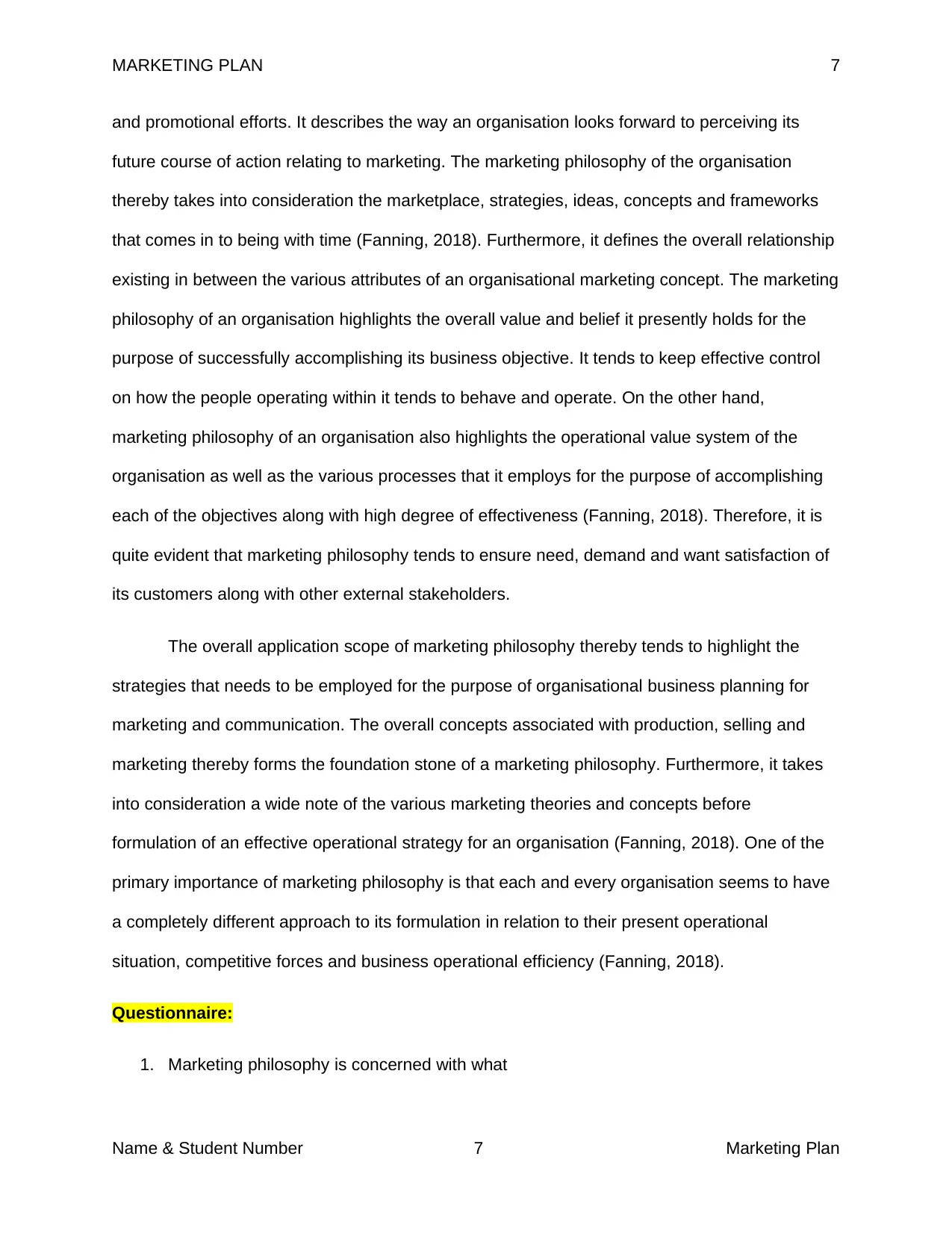
MARKETING PLAN 7
and promotional efforts. It describes the way an organisation looks forward to perceiving its
future course of action relating to marketing. The marketing philosophy of the organisation
thereby takes into consideration the marketplace, strategies, ideas, concepts and frameworks
that comes in to being with time (Fanning, 2018). Furthermore, it defines the overall relationship
existing in between the various attributes of an organisational marketing concept. The marketing
philosophy of an organisation highlights the overall value and belief it presently holds for the
purpose of successfully accomplishing its business objective. It tends to keep effective control
on how the people operating within it tends to behave and operate. On the other hand,
marketing philosophy of an organisation also highlights the operational value system of the
organisation as well as the various processes that it employs for the purpose of accomplishing
each of the objectives along with high degree of effectiveness (Fanning, 2018). Therefore, it is
quite evident that marketing philosophy tends to ensure need, demand and want satisfaction of
its customers along with other external stakeholders.
The overall application scope of marketing philosophy thereby tends to highlight the
strategies that needs to be employed for the purpose of organisational business planning for
marketing and communication. The overall concepts associated with production, selling and
marketing thereby forms the foundation stone of a marketing philosophy. Furthermore, it takes
into consideration a wide note of the various marketing theories and concepts before
formulation of an effective operational strategy for an organisation (Fanning, 2018). One of the
primary importance of marketing philosophy is that each and every organisation seems to have
a completely different approach to its formulation in relation to their present operational
situation, competitive forces and business operational efficiency (Fanning, 2018).
Questionnaire:
1. Marketing philosophy is concerned with what
Name & Student Number 7 Marketing Plan
and promotional efforts. It describes the way an organisation looks forward to perceiving its
future course of action relating to marketing. The marketing philosophy of the organisation
thereby takes into consideration the marketplace, strategies, ideas, concepts and frameworks
that comes in to being with time (Fanning, 2018). Furthermore, it defines the overall relationship
existing in between the various attributes of an organisational marketing concept. The marketing
philosophy of an organisation highlights the overall value and belief it presently holds for the
purpose of successfully accomplishing its business objective. It tends to keep effective control
on how the people operating within it tends to behave and operate. On the other hand,
marketing philosophy of an organisation also highlights the operational value system of the
organisation as well as the various processes that it employs for the purpose of accomplishing
each of the objectives along with high degree of effectiveness (Fanning, 2018). Therefore, it is
quite evident that marketing philosophy tends to ensure need, demand and want satisfaction of
its customers along with other external stakeholders.
The overall application scope of marketing philosophy thereby tends to highlight the
strategies that needs to be employed for the purpose of organisational business planning for
marketing and communication. The overall concepts associated with production, selling and
marketing thereby forms the foundation stone of a marketing philosophy. Furthermore, it takes
into consideration a wide note of the various marketing theories and concepts before
formulation of an effective operational strategy for an organisation (Fanning, 2018). One of the
primary importance of marketing philosophy is that each and every organisation seems to have
a completely different approach to its formulation in relation to their present operational
situation, competitive forces and business operational efficiency (Fanning, 2018).
Questionnaire:
1. Marketing philosophy is concerned with what
Name & Student Number 7 Marketing Plan
Paraphrase This Document
Need a fresh take? Get an instant paraphrase of this document with our AI Paraphraser
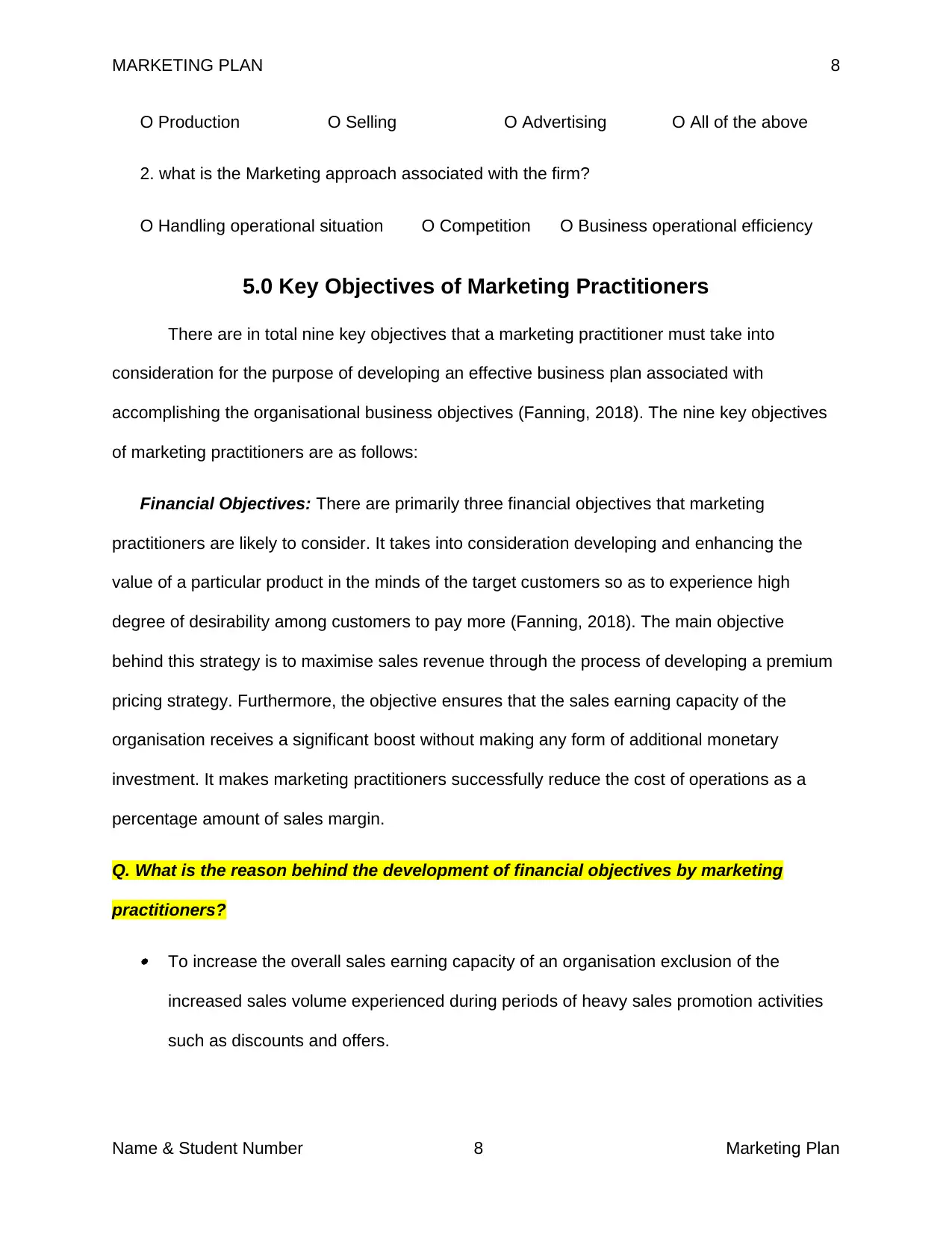
MARKETING PLAN 8
O Production O Selling O Advertising O All of the above
2. what is the Marketing approach associated with the firm?
O Handling operational situation O Competition O Business operational efficiency
5.0 Key Objectives of Marketing Practitioners
There are in total nine key objectives that a marketing practitioner must take into
consideration for the purpose of developing an effective business plan associated with
accomplishing the organisational business objectives (Fanning, 2018). The nine key objectives
of marketing practitioners are as follows:
Financial Objectives: There are primarily three financial objectives that marketing
practitioners are likely to consider. It takes into consideration developing and enhancing the
value of a particular product in the minds of the target customers so as to experience high
degree of desirability among customers to pay more (Fanning, 2018). The main objective
behind this strategy is to maximise sales revenue through the process of developing a premium
pricing strategy. Furthermore, the objective ensures that the sales earning capacity of the
organisation receives a significant boost without making any form of additional monetary
investment. It makes marketing practitioners successfully reduce the cost of operations as a
percentage amount of sales margin.
Q. What is the reason behind the development of financial objectives by marketing
practitioners?
To increase the overall sales earning capacity of an organisation exclusion of the
increased sales volume experienced during periods of heavy sales promotion activities
such as discounts and offers.
Name & Student Number 8 Marketing Plan
O Production O Selling O Advertising O All of the above
2. what is the Marketing approach associated with the firm?
O Handling operational situation O Competition O Business operational efficiency
5.0 Key Objectives of Marketing Practitioners
There are in total nine key objectives that a marketing practitioner must take into
consideration for the purpose of developing an effective business plan associated with
accomplishing the organisational business objectives (Fanning, 2018). The nine key objectives
of marketing practitioners are as follows:
Financial Objectives: There are primarily three financial objectives that marketing
practitioners are likely to consider. It takes into consideration developing and enhancing the
value of a particular product in the minds of the target customers so as to experience high
degree of desirability among customers to pay more (Fanning, 2018). The main objective
behind this strategy is to maximise sales revenue through the process of developing a premium
pricing strategy. Furthermore, the objective ensures that the sales earning capacity of the
organisation receives a significant boost without making any form of additional monetary
investment. It makes marketing practitioners successfully reduce the cost of operations as a
percentage amount of sales margin.
Q. What is the reason behind the development of financial objectives by marketing
practitioners?
To increase the overall sales earning capacity of an organisation exclusion of the
increased sales volume experienced during periods of heavy sales promotion activities
such as discounts and offers.
Name & Student Number 8 Marketing Plan

MARKETING PLAN 9
To decrease the costs of production as a mere percentage of sales by keeping a close
check on the increase in revenue. To win the trust and loyalty of the target customers through the development of a long-
lasting, attractive yet healthy and good business relationship and invest for longer
periods of time.
Strategic Objectives: The strategic objective focusses on making practitioners understand
the relative importance of emerging as a market leader though the process of innovation,
creativity and high degree of uniqueness (Fanning, 2018). It makes the organisations largely
look forward to the aspect of exhibiting rapid adaptability to the emerging operational trends and
processes. The primary objective in this regard is to enjoy high degree of market leadership in
relation to the product being taken into consideration followed by developing a relationship of
trust and confidence customers through operational excellence.
Q. How does the strategic objective tends to influence the operational activities of
marketing personnel as well as the prospective customer segments?
To develop product dominance in the marketplace through the development of items that
are unique and easily distinguishable from others operating in the same business
environmental context and at the same time provide high degree of affordability.
To focus on strengthening the relationship with the customers through understanding of
their needs, demands, taste and preference.
To develop a highly effective and efficient product in comparison to other players in the
market and thereby enjoy significant degree of operational excellence.
Communication Objectives: The communication objective requires marketing practitioners
to develop strategies that tends to successfully communicate the overall value system
associated with the marketing process (Fanning, 2018). It takes into consideration developing
Name & Student Number 9 Marketing Plan
To decrease the costs of production as a mere percentage of sales by keeping a close
check on the increase in revenue. To win the trust and loyalty of the target customers through the development of a long-
lasting, attractive yet healthy and good business relationship and invest for longer
periods of time.
Strategic Objectives: The strategic objective focusses on making practitioners understand
the relative importance of emerging as a market leader though the process of innovation,
creativity and high degree of uniqueness (Fanning, 2018). It makes the organisations largely
look forward to the aspect of exhibiting rapid adaptability to the emerging operational trends and
processes. The primary objective in this regard is to enjoy high degree of market leadership in
relation to the product being taken into consideration followed by developing a relationship of
trust and confidence customers through operational excellence.
Q. How does the strategic objective tends to influence the operational activities of
marketing personnel as well as the prospective customer segments?
To develop product dominance in the marketplace through the development of items that
are unique and easily distinguishable from others operating in the same business
environmental context and at the same time provide high degree of affordability.
To focus on strengthening the relationship with the customers through understanding of
their needs, demands, taste and preference.
To develop a highly effective and efficient product in comparison to other players in the
market and thereby enjoy significant degree of operational excellence.
Communication Objectives: The communication objective requires marketing practitioners
to develop strategies that tends to successfully communicate the overall value system
associated with the marketing process (Fanning, 2018). It takes into consideration developing
Name & Student Number 9 Marketing Plan
⊘ This is a preview!⊘
Do you want full access?
Subscribe today to unlock all pages.

Trusted by 1+ million students worldwide
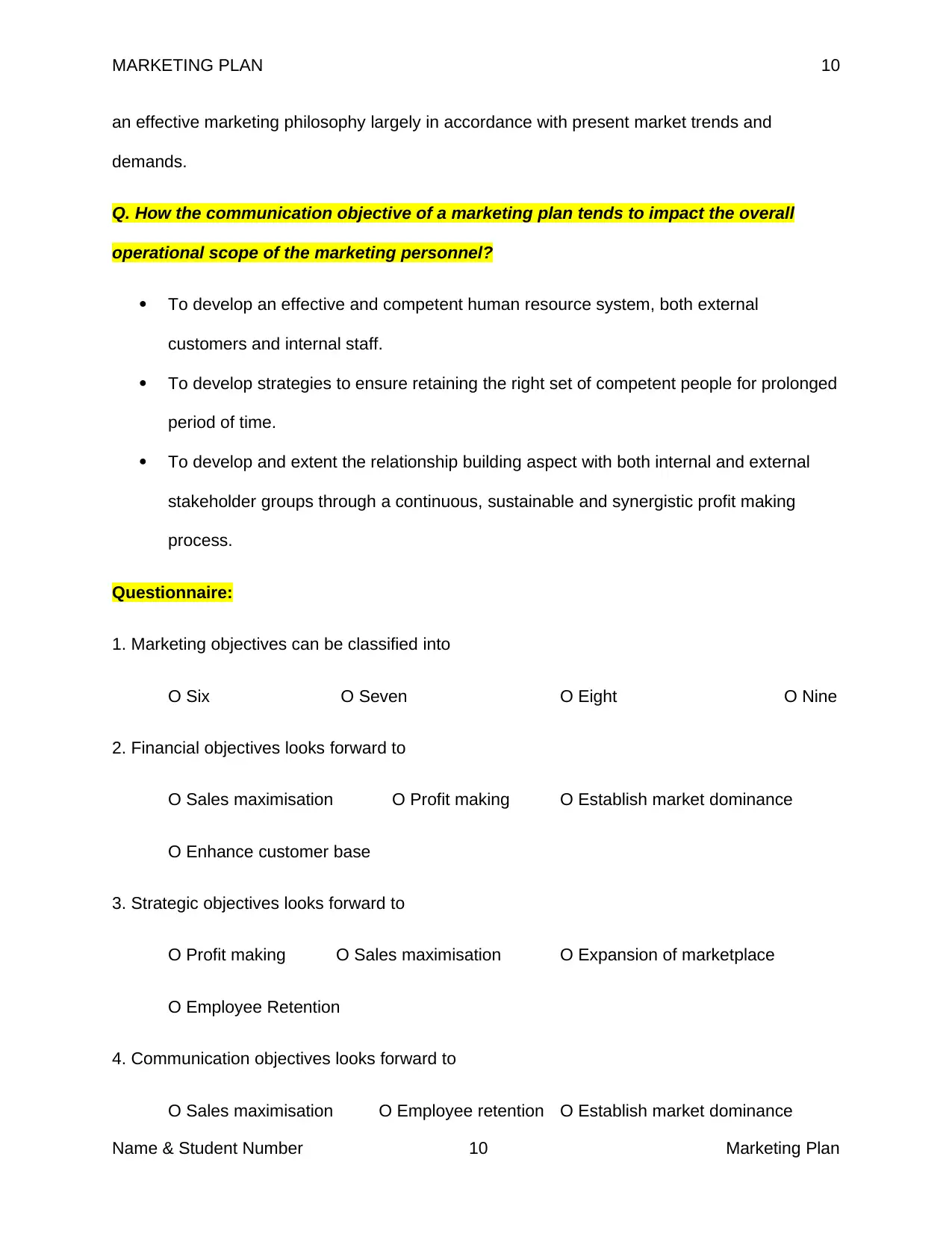
MARKETING PLAN 10
an effective marketing philosophy largely in accordance with present market trends and
demands.
Q. How the communication objective of a marketing plan tends to impact the overall
operational scope of the marketing personnel?
To develop an effective and competent human resource system, both external
customers and internal staff.
To develop strategies to ensure retaining the right set of competent people for prolonged
period of time.
To develop and extent the relationship building aspect with both internal and external
stakeholder groups through a continuous, sustainable and synergistic profit making
process.
Questionnaire:
1. Marketing objectives can be classified into
O Six O Seven O Eight O Nine
2. Financial objectives looks forward to
O Sales maximisation O Profit making O Establish market dominance
O Enhance customer base
3. Strategic objectives looks forward to
O Profit making O Sales maximisation O Expansion of marketplace
O Employee Retention
4. Communication objectives looks forward to
O Sales maximisation O Employee retention O Establish market dominance
Name & Student Number 10 Marketing Plan
an effective marketing philosophy largely in accordance with present market trends and
demands.
Q. How the communication objective of a marketing plan tends to impact the overall
operational scope of the marketing personnel?
To develop an effective and competent human resource system, both external
customers and internal staff.
To develop strategies to ensure retaining the right set of competent people for prolonged
period of time.
To develop and extent the relationship building aspect with both internal and external
stakeholder groups through a continuous, sustainable and synergistic profit making
process.
Questionnaire:
1. Marketing objectives can be classified into
O Six O Seven O Eight O Nine
2. Financial objectives looks forward to
O Sales maximisation O Profit making O Establish market dominance
O Enhance customer base
3. Strategic objectives looks forward to
O Profit making O Sales maximisation O Expansion of marketplace
O Employee Retention
4. Communication objectives looks forward to
O Sales maximisation O Employee retention O Establish market dominance
Name & Student Number 10 Marketing Plan
Paraphrase This Document
Need a fresh take? Get an instant paraphrase of this document with our AI Paraphraser
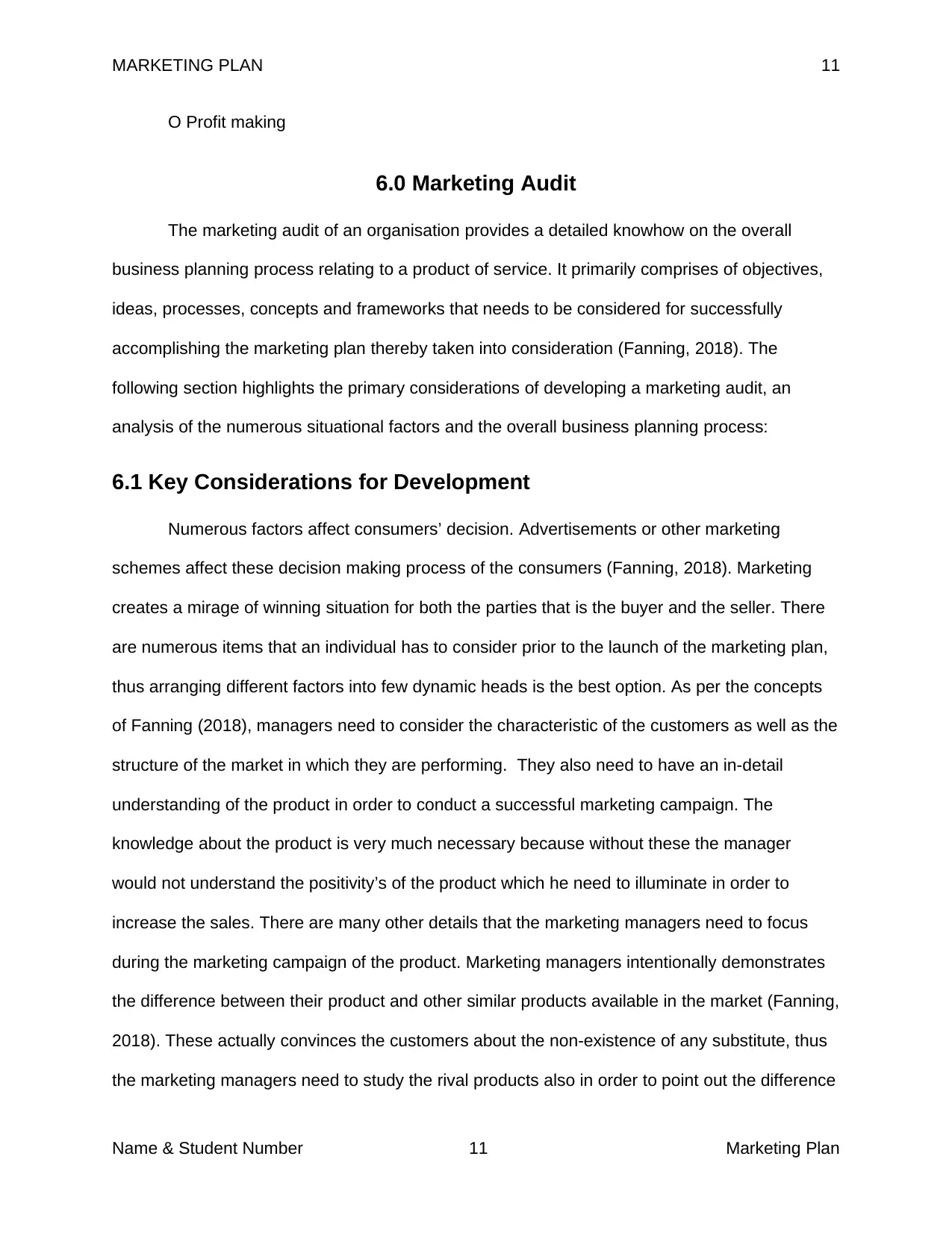
MARKETING PLAN 11
O Profit making
6.0 Marketing Audit
The marketing audit of an organisation provides a detailed knowhow on the overall
business planning process relating to a product of service. It primarily comprises of objectives,
ideas, processes, concepts and frameworks that needs to be considered for successfully
accomplishing the marketing plan thereby taken into consideration (Fanning, 2018). The
following section highlights the primary considerations of developing a marketing audit, an
analysis of the numerous situational factors and the overall business planning process:
6.1 Key Considerations for Development
Numerous factors affect consumers’ decision. Advertisements or other marketing
schemes affect these decision making process of the consumers (Fanning, 2018). Marketing
creates a mirage of winning situation for both the parties that is the buyer and the seller. There
are numerous items that an individual has to consider prior to the launch of the marketing plan,
thus arranging different factors into few dynamic heads is the best option. As per the concepts
of Fanning (2018), managers need to consider the characteristic of the customers as well as the
structure of the market in which they are performing. They also need to have an in-detail
understanding of the product in order to conduct a successful marketing campaign. The
knowledge about the product is very much necessary because without these the manager
would not understand the positivity’s of the product which he need to illuminate in order to
increase the sales. There are many other details that the marketing managers need to focus
during the marketing campaign of the product. Marketing managers intentionally demonstrates
the difference between their product and other similar products available in the market (Fanning,
2018). These actually convinces the customers about the non-existence of any substitute, thus
the marketing managers need to study the rival products also in order to point out the difference
Name & Student Number 11 Marketing Plan
O Profit making
6.0 Marketing Audit
The marketing audit of an organisation provides a detailed knowhow on the overall
business planning process relating to a product of service. It primarily comprises of objectives,
ideas, processes, concepts and frameworks that needs to be considered for successfully
accomplishing the marketing plan thereby taken into consideration (Fanning, 2018). The
following section highlights the primary considerations of developing a marketing audit, an
analysis of the numerous situational factors and the overall business planning process:
6.1 Key Considerations for Development
Numerous factors affect consumers’ decision. Advertisements or other marketing
schemes affect these decision making process of the consumers (Fanning, 2018). Marketing
creates a mirage of winning situation for both the parties that is the buyer and the seller. There
are numerous items that an individual has to consider prior to the launch of the marketing plan,
thus arranging different factors into few dynamic heads is the best option. As per the concepts
of Fanning (2018), managers need to consider the characteristic of the customers as well as the
structure of the market in which they are performing. They also need to have an in-detail
understanding of the product in order to conduct a successful marketing campaign. The
knowledge about the product is very much necessary because without these the manager
would not understand the positivity’s of the product which he need to illuminate in order to
increase the sales. There are many other details that the marketing managers need to focus
during the marketing campaign of the product. Marketing managers intentionally demonstrates
the difference between their product and other similar products available in the market (Fanning,
2018). These actually convinces the customers about the non-existence of any substitute, thus
the marketing managers need to study the rival products also in order to point out the difference
Name & Student Number 11 Marketing Plan
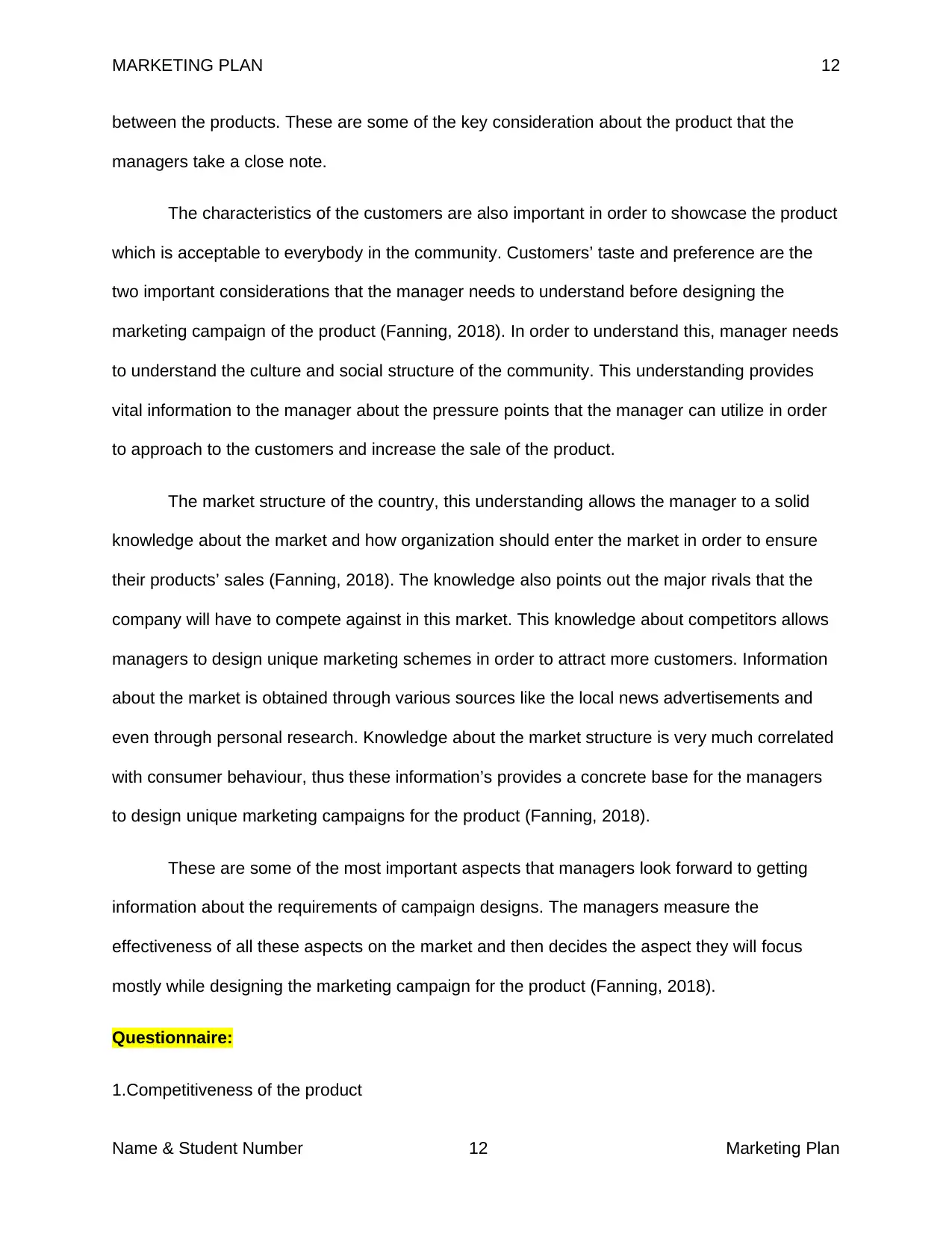
MARKETING PLAN 12
between the products. These are some of the key consideration about the product that the
managers take a close note.
The characteristics of the customers are also important in order to showcase the product
which is acceptable to everybody in the community. Customers’ taste and preference are the
two important considerations that the manager needs to understand before designing the
marketing campaign of the product (Fanning, 2018). In order to understand this, manager needs
to understand the culture and social structure of the community. This understanding provides
vital information to the manager about the pressure points that the manager can utilize in order
to approach to the customers and increase the sale of the product.
The market structure of the country, this understanding allows the manager to a solid
knowledge about the market and how organization should enter the market in order to ensure
their products’ sales (Fanning, 2018). The knowledge also points out the major rivals that the
company will have to compete against in this market. This knowledge about competitors allows
managers to design unique marketing schemes in order to attract more customers. Information
about the market is obtained through various sources like the local news advertisements and
even through personal research. Knowledge about the market structure is very much correlated
with consumer behaviour, thus these information’s provides a concrete base for the managers
to design unique marketing campaigns for the product (Fanning, 2018).
These are some of the most important aspects that managers look forward to getting
information about the requirements of campaign designs. The managers measure the
effectiveness of all these aspects on the market and then decides the aspect they will focus
mostly while designing the marketing campaign for the product (Fanning, 2018).
Questionnaire:
1.Competitiveness of the product
Name & Student Number 12 Marketing Plan
between the products. These are some of the key consideration about the product that the
managers take a close note.
The characteristics of the customers are also important in order to showcase the product
which is acceptable to everybody in the community. Customers’ taste and preference are the
two important considerations that the manager needs to understand before designing the
marketing campaign of the product (Fanning, 2018). In order to understand this, manager needs
to understand the culture and social structure of the community. This understanding provides
vital information to the manager about the pressure points that the manager can utilize in order
to approach to the customers and increase the sale of the product.
The market structure of the country, this understanding allows the manager to a solid
knowledge about the market and how organization should enter the market in order to ensure
their products’ sales (Fanning, 2018). The knowledge also points out the major rivals that the
company will have to compete against in this market. This knowledge about competitors allows
managers to design unique marketing schemes in order to attract more customers. Information
about the market is obtained through various sources like the local news advertisements and
even through personal research. Knowledge about the market structure is very much correlated
with consumer behaviour, thus these information’s provides a concrete base for the managers
to design unique marketing campaigns for the product (Fanning, 2018).
These are some of the most important aspects that managers look forward to getting
information about the requirements of campaign designs. The managers measure the
effectiveness of all these aspects on the market and then decides the aspect they will focus
mostly while designing the marketing campaign for the product (Fanning, 2018).
Questionnaire:
1.Competitiveness of the product
Name & Student Number 12 Marketing Plan
⊘ This is a preview!⊘
Do you want full access?
Subscribe today to unlock all pages.

Trusted by 1+ million students worldwide
1 out of 25
Related Documents
Your All-in-One AI-Powered Toolkit for Academic Success.
+13062052269
info@desklib.com
Available 24*7 on WhatsApp / Email
![[object Object]](/_next/static/media/star-bottom.7253800d.svg)
Unlock your academic potential
Copyright © 2020–2025 A2Z Services. All Rights Reserved. Developed and managed by ZUCOL.




